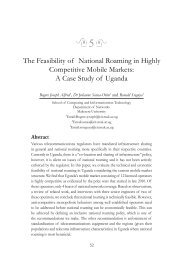Undergraduate Handbook - School of Computing and Informatics ...
Undergraduate Handbook - School of Computing and Informatics ...
Undergraduate Handbook - School of Computing and Informatics ...
Create successful ePaper yourself
Turn your PDF publications into a flip-book with our unique Google optimized e-Paper software.
CSC 1301: Practical Skills Development (4 CU)<br />
Course Description: The course aims at imparting practical skills in areas chosen by the faculty. The students are to<br />
be supervised by staff with in the faculty. Areas <strong>of</strong> practical skills development include; Implementation <strong>of</strong> projects;<br />
Network <strong>and</strong> system administration; Hardware maintenance <strong>and</strong> Computer assembly.<br />
This can be done within the Faculty <strong>of</strong> <strong>Computing</strong> <strong>and</strong> <strong>Informatics</strong> Technology or any other unit in Makerere<br />
University. Students will write a report at the end <strong>of</strong> the course.<br />
CSC 1303: Cisco Certified Network Associate (Audited) (5 CU)<br />
Course Description: In this course, students will cover the course content <strong>of</strong> the CCNA international curriculum.<br />
CSC 1104: Computer Organization & Architecture (4 CU)<br />
Course Description: This course introduces the logical architecture <strong>and</strong> organization <strong>of</strong> computer systems. It<br />
highlights the lower end operations in a typical computer as well as the way computers manage their resources<br />
during operation. The course opens up a student to be an informed user <strong>of</strong> the computer rather than a passive<br />
recipient <strong>of</strong> the computer services. Teaching will be in terms <strong>of</strong> lectures as well as tutorials. The aims <strong>of</strong> the course<br />
are: To introduce to students the concepts <strong>of</strong> computer organization; to highlight to students the way computers<br />
process <strong>and</strong> store the data; to highlight internal management issues in computer systems. By the end <strong>of</strong> the course,<br />
the student will be able to know the organization, processing <strong>and</strong> storage mechanisms <strong>of</strong> computer systems.<br />
Indicative Content<br />
• Data Representation: Integer Formats, Binary, Octal <strong>and</strong> Hexadecimal Systems, Negative integers <strong>and</strong> 2’s<br />
Complement, Floating Point Formats, BCD Formats, Alphanumeric Codes.<br />
• Basic Digital Circuits: Logic gates, Karnaugh maps, Combinatorial Circuits, Binary Adders, Multiplexers<br />
<strong>and</strong> Demultiplexers, Comparators, Decoders <strong>and</strong> Encoders, Code Converters, ROMS <strong>and</strong> PLA’s,<br />
Sequential Circuits, Flip Flops <strong>and</strong> Latches, R-S flip flops, J-K flip flops, T flip Flops, D flip flops,<br />
Registers, Shift Registers <strong>and</strong> Data Transmission, Sequential Network Design.<br />
• Micro Computer Architecture: CPU, Memory, I/O Devices <strong>and</strong> Interfaces, System Bus, Examples <strong>of</strong> CPU<br />
Structures, The Intel Pentium CPU, The Z-80 or Motorolla, Machine Language Instructions, Instruction<br />
Formats <strong>and</strong> Addressing Modes.<br />
• The Processing Elements: Macroinstruction execution, Internal Bus Transfers, Detailed Internal<br />
Architecture, Microcontrol, Hardwired Control, Micro programmed Control, Reduced Instruction Set<br />
Computers.<br />
• I/O Programming: Programmed I/O, Interrupt I/O, Polling, Priority Interrupt System, Direct Memory<br />
Access, I/O processors.<br />
• Memory Systems <strong>and</strong> Memory Management: Memory Hierarchy, Main Memory, Auxiliary Memory,<br />
Associative Memory,<br />
• Cache Memory, Virtual Memory, Memory Management Hardware<br />
Reference Books:<br />
i. M. M. Mano, Computer Systems Architecture, Prentice Hall, 1993.<br />
ii. A. S. Tanebaum, Structured Computer Organization, Prentice Hall 1984.<br />
iii. G. B. Gibson, Computer Systems Concepts <strong>and</strong> Design, Prentice Hall, 1991.<br />
iv. W. Stallings, Computer Organization <strong>and</strong> Architecture, Prentice Hall 2003.<br />
CSC 1105: Numerical Methods (3 CU)<br />
Course Description: The course is to sharpen the students’ skills in using numerical approaches to solve<br />
mathematical/real life problems. The focus will be on the ability to correctly formulate numerical problems <strong>and</strong><br />
schemes that solve them. Emphasis will be put on the precision <strong>and</strong> robustness <strong>of</strong> the schemes. The course will be<br />
59

















